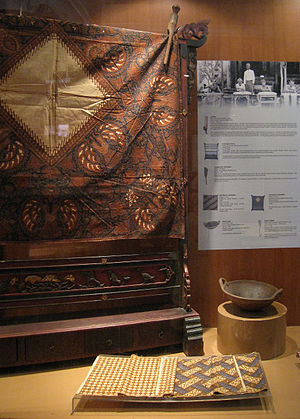Ahmad ibn Hanbal
| Islamic scholar Abu Abdillah Ahmed ibn Muhammed ibn Hanbal al-Shaybani |
|
|---|---|
| Title | Sheikh ul-Islam |
| Born | 780 CE/164 AH[1] Baghdad, Iraq[2] )[3] |
| Died | 855 CE/241 AH (aged 74-75)[1] Baghdad, Iraq[4] |
| Ethnicity | Arab |
| Era | Islamic Golden Age |
| Region | Iraq |
| Jurisprudence | Ijtihad |
| Creed | Athari |
| Main interest(s) | Fiqh, Hadith, Aqeedah[4] |
| Notable idea(s) | Hanbali madhhab |
| Notable work(s) | Musnad Ahmad ibn Hanbal |
Biography
Early life and family
Ahmad ibn Hanbal's family was originally from Basra, Iraq, and belonged to the Arab Banu Shayban tribe.His father was an officer in the Abbasid army in Khorasan and later settled with his family in Baghdad, where Ahmad was born in 780 CE.Ibn Hanbal had two wives and several children, including an older son, who later became a judge in Isfahan.
Education and Work
Ibn Hanbal studied extensively in Baghdad, and later traveled to further his education. He started learning jurisprudence (Fiqh) under the celebrated Hanafi judge, Abu Yusuf, the renowned student and companion of Imam Abu Hanifah. After finishing his studies with Abu Yusuf, ibn Hanbal began traveling through Iraq, Syria, and Arabia to collect hadiths, or traditions of the Prophet Muhammad. Ibn al-Jawzi states that Imam Ahmad had 414 Hadith masters whom he narrated from. With this knowledge, he became a leading authority on the hadith, leaving an immense encyclopedia of hadith, the al-Musnad. After several years of travel, he returned to Baghdad to study Islamic law under al-Shafi. He became a mufti in his old age, but is remembered most famously, as the founder of the Hanbali madhab or school of Islamic law, which is now most dominant in Saudi Arabia, Qatar as well as the United Arab Emirates.In addition to his scholastic enterprises, ibn Hanbal was a soldier on the Islamic frontiers (Ribat) and made Hajj five times in his life, twice on foot.
Death
Ahmad Ibn Hanbal died in 855 CE in Baghdad, Iraq.The Mihna
Main article: Mihna
Ibn Hanbal was famously called before the Inquisition or Mihna of the Abassid Caliph al-Ma'mun. Al-Ma'mun wanted to assert the religious authority of the Caliph by pressuring scholars to adopt the Mu'tazila view that the Qur'an was created rather than uncreated. According to Sunni tradition, ibn Hanbal was among the scholars to resist the Caliph's interference and the Mu'tazila doctrine of a created Qur'an—although some Orientalist sources raise a question on whether or not he remained steadfastDue to his refusal to accept Mu'tazilite authority, ibn Hanbal was imprisoned in Baghdad throughout the reign of al-Ma'mun. In an incident during the rule of al-Ma'mun's successor, al-Mu'tasim, ibn Hanbal was flogged to unconsciousness. However, this caused upheaval in Baghdad and al-Ma'mun was forced to release ibn Hanbal. After al-Mu’tasim’s death, al-Wathiq became caliph and continued his predecessors policies of Mu'tazilite enforcement and in this pursuit, he banished ibn Hanbal from Baghdad. It was only after al-Wathiqu's death and the ascent of his brother al-Mutawakkil, who was much friendlier to the more traditional Sunni dogma, that ibn Hanbal was welcomed back to Baghdad.
Works
The following books are found in Ibn al-Nadim's Fihrist:- Kitab al-`Ilal wa Ma‘rifat al-Rijal: "The Book of Narrations Containing Hidden Flaws and of Knowledge of the Men (of Hadeeth)" Riyad: Al-Maktabah al-Islamiyyah
- Kitab al-Manasik: "The Book of the Rites of Hajj"
- Kitab al-Zuhd: "The Book of Abstinence" ed. Muhammad Zaghlul, Beirut: Dar al-Kitab al-'Arabi, 1994
- Kitab al-Iman: "The Book of Faith"
- Kitab al-Masa'il "Issues in Fiqh"
- Kitab al-Ashribah: "The Book of Drinks"
- Kitab al-Fada'il Sahaba: "Virtues of the Companions"
- Kitab Tha'ah al-Rasul : "The Book of Obedience to the Messenger"
- Kitab Mansukh: "The Book of Abrogation"
- Kitab al-Fara'id: "The Book of Obligatory Duties"
- Kitab al-Radd `ala al-Zanadiqa wa'l-Jahmiyya "Refutations of the Heretics and the Jahmites" (Cairo: 1973)
- Tafsir : "Exegesis"
- the Musnad
Quotes
- It is said that, when told that it was religiously permissible to say what pleases his persecuters without believing in it at the time of mihna, Ahmad said "If I remained silent and you remained silent, then who will teach the ignorant?".
- With regard to innovation within religion, Ahmad said “The graves of sinners from People of Sunnah is a garden, while the graves of the pious ascetics from the People of Innovation is a barren pit. The pious among Ahlus Sunnah are the Friends of Allah, while the sinners among Ahlul-Bidah are the Enemies of Allah.”
Historical views
Ibn Hanbal has been extensively praised for both his work in the field of prophetic tradition and his defense of orthodox Sunni dogma. Abdul-Qadir Gilani stated that a Muslim could not truly be a wali of God except that they were upon Ibn Hanbal's creed; despite praise from his contemporaries as well, Yahya ibn Ma'in noted that Ibn Hanbal never boasted about his achievements.His juristic views were not always accepted. Qur'anic exegete Muhammad ibn Jarir al-Tabari, who at one time had sought to study under Ibn Hanbal, later stated he didn't consider Ibn Hanbal a jurist and gave his views in the field no weight, describing him as an expert in prophetic tradition only.Likewise, Andalusian scholar Ibn 'Abd al-Barr didn't include Ibn Hanbal or his views in his book The Hand-Picked Excellent Merits of the Three Great Jurisprudent Imâms about the main representatives of Sunni jurisprudence. Thus, while Ibn Hanbal's prowess in the fied of tradition appears to be undisputed, his status as a jurist has not enjoyed the same reception.





